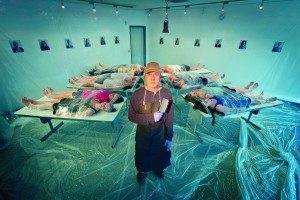
professor of the class, put together a class photo based on the popular television series “Dexter.”
While most see photography as an art for capturing memories, Stephen Chalmers, assistant professor of photography, uses his extensive experience with the art to create new memories for him and his students at Youngstown State University.
Chalmers started teaching in 2001 at Central Washington University in Ellensburg, Washington. While at CWU he taught his students to make large format prints — 4-foot or larger — and instead of using a photograph that was already taken, he decided to have them stage their own class photo and work through the development process as a class.
“I didn’t want to have the students spend two hours making a print from one of my prints,” Chalmers said. “I decided to turn it into an assignment working collaboratively to create their own photograph using techniques that they learned during class.”
Chalmers decided to continue this practice when he started at YSU.
The project allowed students to break out of the traditional independent workflow and work as a group to create a properly produced image from start to finish.
“I viewed it as a useful assignment in that the students would have to work with one another, which is what one’s entire work life is about,” Chalmers said. “A lot of art students work alone in their studio and then go out into the world where collaborative working, more often than not, is more important than anything else.”
According to Chalmers, the assignment also allows students to work firsthand using techniques they have learned in class.
“Students are able to see firsthand how location lighting works and also finding a location to fit the scene they wish to portray instead of trying to create something in a studio,” he said. “They are able to see how things work in the real world.”
Junior Danielle Beaumier majors in photography and feels that the class photos are a great opportunity to use the skills and creativity learned in class.
“I think the class photos are a great way to practice our skills and to bring the class together as a whole. I’ve been involved in a few and I have never had a bad time,” Beaumier said. “It’s fun to work on a project like that without the pressure of being graded on it.”
The photos are not just used as a class exercise, but are made as keepsakes for the students.
“When they pull the photo out 20 years later, after they have a family and a job somewhere else, I’d like to think that this is an encapsulation of their experience here,” Chalmers said. “I like to think of my students pulling out these pictures in their 50s and pondering about what their 20-year-old selves were like.”
Each student brings in two ideas of what they would like to do and the photographs are voted on until the class decides on the most popular idea. The result is an eclectic batch of themed-photographs across the years, from “Alice in Wonderland” to “Breaking Bad.”
“We spend class time discussing different ideas and methods. Everything is planned out beforehand: the situation, the roles we put ourselves in, the props and location,” Beaumier said. “The students have complete control. We shoot a lot of different angles and decide on the best image as a class and edit it together.”
Beaumier added that the whole project is well organized and runs smoothly because of this.
“Honestly the whole process is fairly organized and we vote on ideas. If there is a tie, we try and combine ideas to the best of our ability,” she said. “Getting ready for a strange shoot is always interesting.”
The process gives students the opportunity to put together images in a truly artistic way, instead of just snapping a picture.
“As photographers we do not ‘take’ pictures,” Chalmers said. “We ‘make’ photographs because everything that we frame up in the lens should be thought up and put in that specific place for a reason.”
Senior Jarrod MacCartney’s favorite image was a family Christmas party when he had to find an ugly sweater and take an awkward picture like the typical family portrait.
“I guess that one is my favorite just because it felt like we really were having a mini Christmas together,” MacCartney said. “In a sense they are family to me — my photo family.”